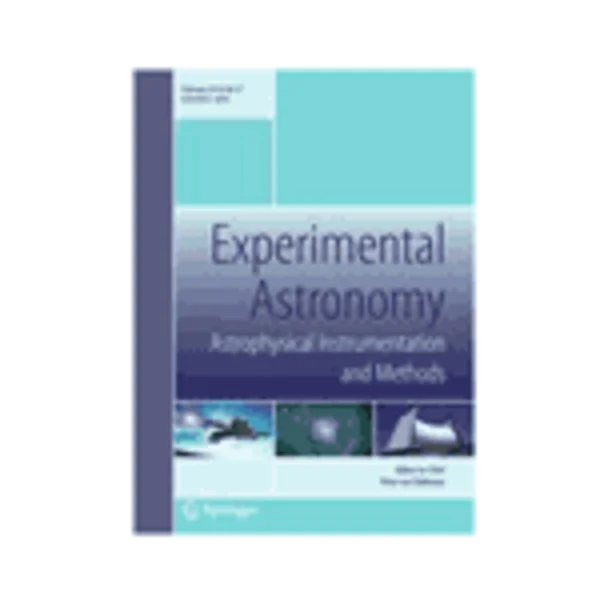-
integral wide-field spectroscopy in astronomy: the imaging fts solution
جزئیات بیشتر مقاله- تاریخ ارائه: 1392/07/24
- تاریخ انتشار در تی پی بین: 1392/07/24
- تعداد بازدید: 985
- تعداد پرسش و پاسخ ها: 0
- شماره تماس دبیرخانه رویداد: -
long-slit grating spectrometers in scanning mode and fabry–perot interferometers as tunable filters are commonly used to perform integral wide-field spectroscopy on extended astrophysical objects as hii regions and nearby galaxies. the goal of this paper is to demonstrate, by comparison, through a thorough review of the imaging fourier transform spectrometer (ifts) properties, that this instrument represents another interesting solution. after a brief recall of the performances, regarding fov and spectral resolution, of the grating spectrometer, without and with integral field units (ifu), and of the imaging fabry–perot, it is demonstrated that for an ifts the product of the maximum resolution r by the entrance beam étendue u is equal to with the number of pixels of the detector array and s the area of the interferometer beamsplitter. as a consequence, the ifts offers the most flexible choice of field size and spectral resolution, up to high values for both parameters. it also presents on a wide field an important multichannel advantage in comparison to integral field grating spectrometers, even with multiple ifus. to complete, the few astronomical iftss, built behind ground-based telescopes and in space, for the visible range up to the sub-millimetric domain, are presented. through two wide-field ifts projects, one in the visible, the other one in the mid-infrared, the question is addressed of the practical fov and resolution limits, set by the optical design of the instrument, which can be achieved. within the 0.3 to 2.5 m domain, a michelson interferometer with wide-field diopric collimators provides the easiest solution. this design is illustrated by a -field ifts in the 0.35–0.90 m range around an off-axis interferometer, called sitelle, proposed for the 3.6-m cfh telescope. at longer wavelengths, an all-mirror optics is required, as studied for a spaceborne ifts, h2ex, for the 8–29 m range, a field, and a high resolution of at 10 m. to comply with these characteristics, the interferometer is designed with cat’s eye retroreflectors. in the same domain and up to the far infrared, if the instrument aims only at a low spectral resolution (few thousands) and a smaller field (few arcmins ), roof-top or corner cube mirrors, as for the ifts spire on the herschel space telescope, are usable. at last, perspectives are opened, behind an elt in the visible and the near infrared with the sitelle optical combination, in the 2–5 m on the antarctic plateau or in space up to longer wavelengths, with the h2ex design, to provide the missing capability of global high spectral resolution studies of extended sources, from comets to distant galaxy clusters.
مقالات جدیدترین رویدادها
-
استفاده از تحلیل اهمیت-عملکرد در ارائه الگوی مدیریت خلاقیت سازمانی و ارائه راهکار جهت بهبود
-
بررسی تاثیر ارزش وجوه نقد مازاد بر ساختار سرمایه شرکت های پذیرفته شده در بورس اوراق بهادار تهران
-
بررسی تأثیر سطح افشای ریسک بر قرارداد بدهی شرکت های پذیرفته شده در بورس اوراق بهادار تهران
-
بررسی تأثیر رتبه بندی اعتباری مبتنی بر مدل امتیاز بازار نوظهور بر نقد شوندگی سهام با تأکید بر خصوصی سازی شرکت ها
-
تأثیر آمیخته بازاریابی پوشاک ایرانی بر تصویر ذهنی مشتری پوشاک ایرانی (هاکوپیان)
-
بررسی اثر پارامترهای سطوح مشترک بر رفتار دیوارهای حایل سنگ چین با استفاده از روش اجزا منفصل
-
اثرات کوتاه و طولانی مدت عصاره پرسیاوشان روی هموگلوبین، هماتوکریت، حجم گلبول های قرمز، زمان پروترومبین و زمان ترومبوپلاستین
-
بررسی جهش هاى نادر ژن بتاگلوبین در شمال غرب کشور
-
simulation of polycrystal deformation with grain and grain boundary effects
-
determination of mechanical properties of soft tissue scaffolds by atomic force microscopy nanoindentation
مقالات جدیدترین ژورنال ها
-
مدیریت و بررسی افسردگی دانش آموزان دختر مقطع متوسطه دوم در دروان کرونا در شهرستان دزفول
-
مدیریت و بررسی خرد سیاسی در اندیشه ی فردوسی در ادب ایران
-
واکاوی و مدیریت توصیفی قلمدان(جاکلیدی)ضریح در موزه آستان قدس رضوی
-
بررسی تاثیر خلاقیت، دانش و انگیزه کارکنان بر پیشنهادات نوآورانه کارکنان ( مورد مطالعه: هتل های 3 و 4 ستاره استان کرمان)
-
بررسی تاثیر کیفیت سیستم های اطلاعاتی بر تصمیم گیری موفق در شرکتهای تولیدی استان اصفهان (مورد مطالعه: مدیران شرکتهای تولیدی استان اصفهان)
-
نقش حسابداری مدیریت استراتژیک در عملکرد سازمانی (مطالعه موردی : هتل های 5 ستاره شهر تهران)
-
طراحی الگوی سقف شیشه ای با رویکرد نظریه داده بنیاد
-
بررسی عوامل موثر مدل سازی فرآیندهای کسب و کار(bpm) در قالب چارچوب itil جهت ارتقای هوش تجاری (bi) در سازمان تامین اجتماعی تهران
-
نقش ویژگی های کمیته حسابرسی بر رابطه بین انطباق مالیاتی و هموارسازی سود
-
بررسی ارتباط بین ضعف کنترل های داخلی و همزمانی قیمت سهام در شرکت های پذیرفته شده در بورس اوراق بهادار تهران: تبیین نقش تعدیلگر ویژگی های هیئت مدیره




سوال خود را در مورد این مقاله مطرح نمایید :